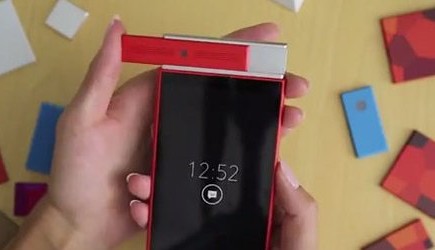Google Realizes Phonebloks: The Open Source Modular Smartphone
April 10, 2014
on
on

Phonebloks, the open hardware platform for creating highly modular smartphones that made a big splash last year as a concept of a Dutch design student, is now being realized by Google under the name project Ara for a starting price of $50.
The modular phone consists of separate components which can be put together like lego. Users can assemble their own device to their taste, spending money on quality camera's or battery performance.
Last week Google revealed a first peak at project Ara with a video of the prototype. The modules are loosely assembled in a frame but when the power comes on they are securely held in place by electro-permanent magnets. After witnessing this feat the designers decided that the phone will not have an encasing allowing its modularity to be visible on the outside.
Phonebloks
The concept of a modular phone gained worldwide popularity last year thanks to the graduation project of design student Dave Hakkens. He released a video showing the concept and the design of the modular phone called phonebloks which made everybody realize they wanted one.
For Hakkens the main purpose of the modular phone is waste reduction. Now people throw away their phone when one component is broken or when they want the newest feature. But he also pointed out that extreme customization and third-party development could launch the next revolution in mobile phones. Third-party development would allow anybody with a good idea to contribute to a market that is notorious for its high barrier to entry.
Hakkens called out to manufacturers around the world to get going with the Phonebloks concept, rallying almost a million people to join a thunderclap to broadcast the message.
Technical Limitations
There was some scepticism amongst technologists. George Hahn explained the technical limitations on GenericMaker.com
Third Party Developer Conference
But Motorola, the hardware manufacturer bought by Google, had already started working on it. When they saw Hakkens drumming up interest for the concept they contacted him to collaborate on a 'shared vision'.
Motorolla has since been sold to Lenovo, the computer manufacturer that builds the only laptops certified for use at the International Space Station, but Google kept the Ara project. Now the first prototype has been revealed just weeks ahead of the first project Ara third party developer conference on April 15-16.
The modular phone consists of separate components which can be put together like lego. Users can assemble their own device to their taste, spending money on quality camera's or battery performance.
Last week Google revealed a first peak at project Ara with a video of the prototype. The modules are loosely assembled in a frame but when the power comes on they are securely held in place by electro-permanent magnets. After witnessing this feat the designers decided that the phone will not have an encasing allowing its modularity to be visible on the outside.
Phonebloks
The concept of a modular phone gained worldwide popularity last year thanks to the graduation project of design student Dave Hakkens. He released a video showing the concept and the design of the modular phone called phonebloks which made everybody realize they wanted one.
For Hakkens the main purpose of the modular phone is waste reduction. Now people throw away their phone when one component is broken or when they want the newest feature. But he also pointed out that extreme customization and third-party development could launch the next revolution in mobile phones. Third-party development would allow anybody with a good idea to contribute to a market that is notorious for its high barrier to entry.
Hakkens called out to manufacturers around the world to get going with the Phonebloks concept, rallying almost a million people to join a thunderclap to broadcast the message.
Technical Limitations
There was some scepticism amongst technologists. George Hahn explained the technical limitations on GenericMaker.com
It’s a physics issue. Signals in modern devices are extremely high speed; the easiest and cheapest way to combat this is to bring components closer together. For example, the wireless radios, RAM, and processor in all modern phones exist as one chip. They essentially put the CPU and wireless magic on the same silicon die (or on a separate die in the same package) and pop a RAM chip on top (“Package on Package”).
Third Party Developer Conference
But Motorola, the hardware manufacturer bought by Google, had already started working on it. When they saw Hakkens drumming up interest for the concept they contacted him to collaborate on a 'shared vision'.
Motorolla has since been sold to Lenovo, the computer manufacturer that builds the only laptops certified for use at the International Space Station, but Google kept the Ara project. Now the first prototype has been revealed just weeks ahead of the first project Ara third party developer conference on April 15-16.
Read full article
Hide full article


Discussion (0 comments)